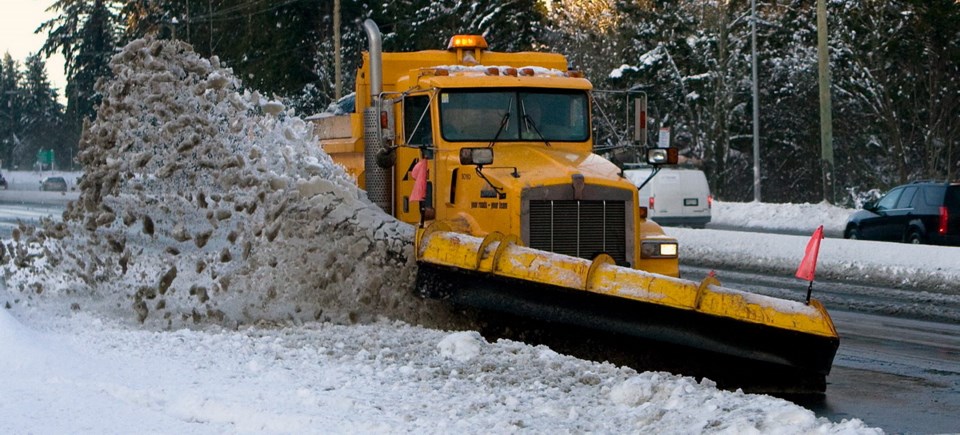 Love Dodd’s 4x4 was the last vehicle down the Malahat before they shut the highway Sunday night.
Love Dodd’s 4x4 was the last vehicle down the Malahat before they shut the highway Sunday night.
He made it through just before a following carload of friends — mom, dad and two kids — was stopped and turned back toward Duncan. The friends couldn’t find a hotel, so ended up bunking in with a Mill Bay woman who works with Dodd and was kind enough to open her door to strangers.
Dodd and family made it home, though the trip through the blizzard was still one that most Vancouver Islanders would rather leave to the rest of the Great White-Knuckled North.
“I’ve never driven through weather like that before,” Dodd said Monday. “It was a seven-hour drive from Mount Washington to Victoria with a three-year-old and a seven-year-old. That was fun.”
Good thing he got new snow tires on Thursday. There were cars in the ditch, cars spinning out in front of him, cars stuck smack in middle of the road like markers on a slalom course.
In fact, it was those obstacle-course cars, along with a transport truck blocking the highway at Tunnel Hill, that made it impossible for the snowplows to do their job. When the snow is hammering down like that, the plows must keep to a steady schedule to keep the Malahat passable.
“The key to our success is our cycle times,” said Chris Crowley, the operations manager for Mainroad South Island, which maintains 3,600 lane-kilometres of road — pretty much all the non-municipal roads south of Ladysmith, plus the Gulf Islands.
At times like this, Mainroad has all its snow-fighting equipment — 40 trucks, plus graders — going 24-7, with drivers hot-seating 12-hour shifts.
It’s like that throughout the region right now, people pulling extra duty to plow the streets and restore power to our homes. And those of us who are cowering in our homes, nervously peeking out the curtains, might want to thank those who are toiling outside to get us through Snowmageddon. We might also want to do what we can to help them do their jobs.
How your roads get cleared depends on where you live. Not all jurisdictions have the same capacity to plow.
The roads Mainroad maintains are ranked A through F, with priority given to keeping A routes (major highways) and B routes (West Coast Road west of Sooke, for example) open.
In Saanich, which has eight vehicles to salt and sand the roads, priority goes to emergency access routes, main roads, major bus routes and steep hills. Langford, View Royal and Highlands all hire the same private contractor to plow ’round the clock.
The City of Victoria, which began rotating public works crews on 12-hour shifts Sunday, ranks roads one to three, with group one echoing Saanich’s priority list. Victoria deploys five dump trucks with plows and salters, a couple of smaller, similarly equipped trucks, and an assortment of smaller vehicles: Bobcats with broom attachments, even a new rubberized plow bought with the Johnson Street Bridge deck in mind. And yes, neighbouring municipalities now co-ordinate their efforts, unlike the Blizzard of ’96, when plowing often ended at municipal borders.
Hilly Colwood has four five-tonne trucks with salters and carbide-belly plows, plus a couple of one-tonnes with front blades that they use to clean up following the snowfall.
Remember that most of the people driving these vehicles have been thrown into the breach. John Russell, who works for Colwood’s public works department, was supposed to have Sunday off, but spent the morning sawing up trees that had fallen on Ocean Boulevard during the weekend’s windstorm. Then he started plowing the roads. When he hopped out of the truck late that night, he still had the hard hat and faceshield he wore while using the chainsaw. (“What were you doing?” asked a co-worker. “Weedwhacking?”) He was back at it for another 12-hour shift Monday.
It’s rewarding work, Russell said. People are happy to see the plow coming over the hill like the cavalry. “They wave from their driveways.”
Dealing with traffic — cars in which neither the drivers nor their tires should be out in the snow — can be a challenge, though. It would really help if people would park in their driveways, not on the street, particularly on the bits where the plows need to get a bit of speed up. Likewise, Crowley urges drivers to keep their distance from snow-clearing vehicles.
Keeping the roads clear is a challenge on days like this. Those of us who aren’t doing the work can at least make it easier on those who are.



